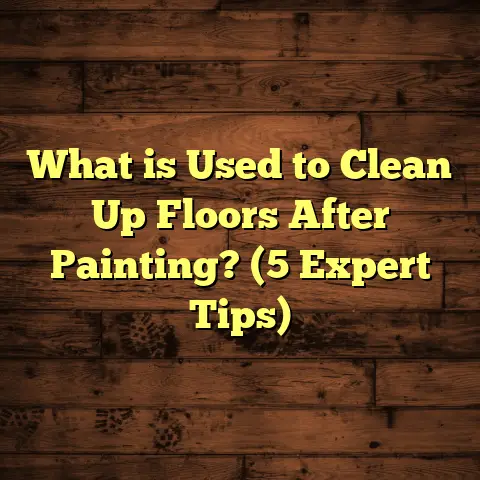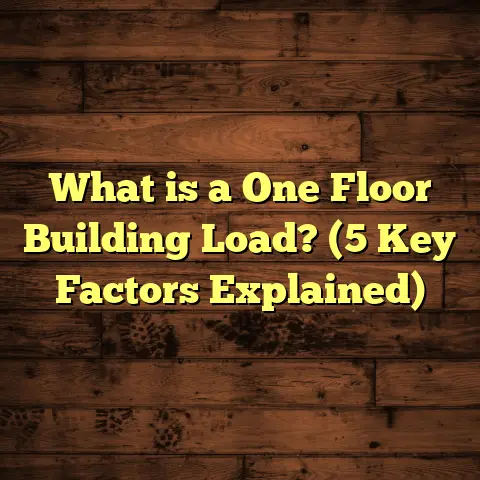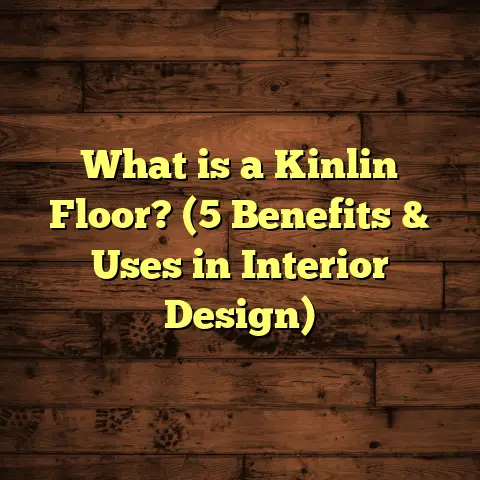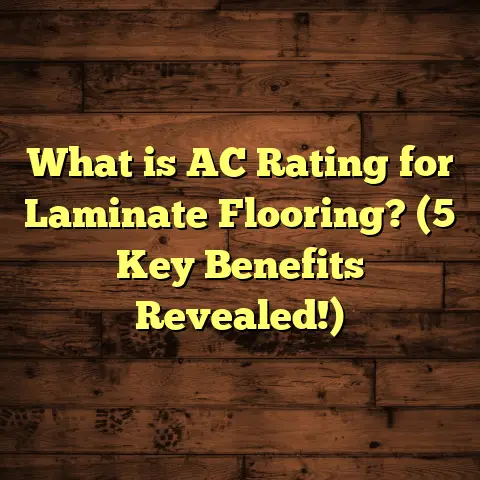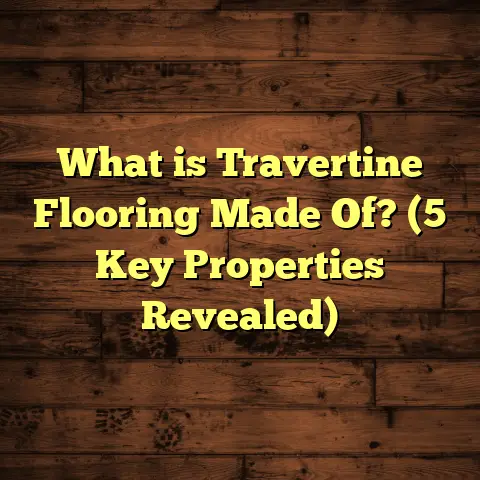What is Luxury Vinyl Tiles? (5 Benefits for Stylish Floors)
Did you know that luxury vinyl tiles (LVT) have grown to become one of the most popular flooring choices in both homes and commercial spaces worldwide? When I first stumbled across LVT during a renovation project years ago, I was honestly skeptical. Could a synthetic floor really match the warmth and beauty of hardwood or natural stone? The answer surprised me. Over time, I’ve learned not only how beautiful and versatile LVT can be but also how practical it is for everyday living. Since then, I’ve installed it in dozens of projects and seen it hold up under all kinds of conditions. Let me share what I’ve learned about luxury vinyl tiles—their benefits, installation tips, costs, maintenance, and everything in between.
What Is Luxury Vinyl Tiles (LVT)?
Luxury vinyl tiles are a type of resilient flooring made from multiple layers of synthetic materials designed to mimic the appearance and texture of natural flooring like hardwood, ceramic tile, or stone. Unlike traditional vinyl sheets that come in rolls and cover large areas uniformly, LVT is manufactured as individual tiles or planks. This format gives you more flexibility when it comes to patterns, designs, and ease of installation.
The structure of LVT usually includes:
- Wear Layer: This is the clear topcoat that protects against scratches, scuffs, and stains. The thickness of this layer varies depending on the grade of the product.
- Design Layer: This is a high-resolution printed layer that features the realistic image of wood grain, stone veining, or other textures.
- Core Layer: Provides stability and resilience. Some LVT products have a rigid core for added durability.
- Backing Layer: Adds support and moisture resistance.
What really caught my attention early on was how advanced the printing technology has become. The textures are embossed right into the tile’s surface, making them feel almost indistinguishable from real wood or stone underfoot.
I’ve seen clients who initially doubted LVT’s authenticity become huge fans once they saw it installed. It doesn’t just look good in photos—it truly transforms a space.
A Brief History: How Did LVT Become So Popular?
Luxury vinyl tile first appeared in the flooring market decades ago but was often dismissed as “cheap” or “plastic-looking.” Over the last 10-15 years, however, manufacturers have invested heavily in improving quality and realism.
Early vinyl floors were often thin and lacked durability. But now with thicker wear layers (up to 30 mils in some commercial-grade products), advanced printing methods, and enhanced cores that resist denting or moisture damage, LVT has crossed over into mainstream acceptance.
Its surge in popularity also ties closely to lifestyle changes—more people want stylish floors that can withstand pets, kids, spills, and heavy foot traffic without constant upkeep.
5 Reasons I Keep Recommending Luxury Vinyl Tiles
1. Stunning Realism in Design Options
One thing I always tell clients is: if you want beautiful floors but worry about cost or maintenance, LVT offers an incredible range of styles. From distressed hardwood looks with knots and grain texture to glossy marble tiles with natural veining—there’s something for every taste.
According to a 2023 survey by Floor Trends Magazine:
“More than 70% of homeowners selected LVT due to its ability to replicate natural wood or stone aesthetics with exceptional detail.”
The variety extends beyond just visuals. You can find:
- Wood plank styles in widths ranging from 4 inches up to 9 inches.
- Stone-look tiles in various shapes like hexagons or large squares.
- Unique patterns like herringbone or chevron pre-cut for easy installation.
- Color options from light blond oak to deep espresso hues.
Personally, I’ve used LVT to replicate rare hardwood species that are hard to source sustainably or would be prohibitively expensive. It gives clients a chance to have those designs without the environmental or budget concerns.
2. Durability That Stands Up to Life’s Challenges
If you’re like me and have kids or pets running around the house (or you own a busy retail location), durability is a top concern. Hardwood floors can scratch easily; carpet stains; and tile can crack or chip.
Luxury vinyl tiles are specifically engineered for resilience.
- The wear layers resist scuffs from shoes and claws.
- The core layer absorbs impact and prevents cracking.
- Many products offer scratch-resistant coatings tested against common household chemicals.
Research from the National Floor Covering Association shows:
“High-quality LVT floors maintain their appearance for 15–20 years under normal residential use.”
In my own projects, I’ve seen LVT installed in restaurants where spills happen daily yet floors still look flawless after several years.
3. Water Resistance Means You Can Use It Almost Anywhere
One surprising fact for many is that LVT is highly water-resistant—even waterproof in many cases—making it suitable for rooms where hardwood simply won’t survive.
Bathrooms, kitchens, basements? No problem.
For example, I worked with a client who had frequent basement flooding issues. We installed waterproof LVT planks with a locking system that kept moisture out. Months later, the floors were still perfect while neighboring units had warped hardwood or ruined laminate.
This moisture tolerance makes LVT attractive for commercial spaces like gyms, spas, and healthcare facilities where hygiene and spill management are priorities.
4. Installation Is Faster and More Flexible Than You Might Think
One thing I appreciate about LVT is how much easier it is to install compared to other flooring types.
Depending on the product chosen:
- Some LVT options come with click-lock edges that fit together like puzzle pieces—no glue needed.
- Peel-and-stick varieties allow quick placement over existing subfloors.
- Loose lay options can sometimes be floated over existing tile or concrete.
When I’m planning a job, I use FloorTally to estimate installation costs accurately by inputting local labor rates, material prices, waste factors, and project size. This helps avoid budget surprises and speeds up decision-making.
Because LVT tiles come individually sized (typically 12 x 24 inches or similar), you can create custom patterns without complicated cuts like large sheet vinyl requires. This flexibility also means less waste during installation—usually around 5% compared to 10-15% for tile cutting.
5. Low Maintenance for Busy Households
If you don’t want to spend hours maintaining your floor but still want it looking fresh year-round, LVT is an easy choice.
From my experience with clients:
- Sweeping or vacuuming regularly prevents dirt buildup.
- Damp mopping with manufacturer-recommended cleaners keeps surfaces shiny.
- No sanding or refinishing needed.
- Resistant to stains from wine spills or pet accidents when cleaned quickly.
For example, a family I worked with swapped their carpet for LVT in their living area due to allergies and pet odors. They told me they noticed an immediate difference because the floor didn’t trap dust or dander—and cleanup became a breeze.
Using Luxury Vinyl Tiles: Where They Shine Best
When advising friends or clients on where to use LVT, I always ask about lifestyle habits and room conditions.
Here are common applications where I’ve seen LVT work beautifully:
Kitchens & Bathrooms
Because of moisture resistance and ease of cleaning, these rooms benefit greatly from LVT flooring. It’s tough enough to handle dropped utensils or spilled liquids without damage.
In kitchens, the realistic wood-look planks add warmth while resisting stains from cooking spills. In bathrooms, stone-look tiles offer a spa-like feel without the coldness of ceramic tile underfoot.
Living Rooms & Bedrooms
In social spaces where comfort matters but durability is still needed (especially with kids), LVT is ideal.
I’ve installed wood-look luxury vinyl planks in open-plan living rooms that connect seamlessly with kitchen areas—creating a unified look that’s stylish yet practical.
Basements & Laundry Rooms
Basements often pose challenges due to moisture issues. Solid-core waterproof LVT variants stand up well here and brighten otherwise dark spaces.
Laundry rooms are another spot where water resistance is critical; LVT handles occasional leaks better than hardwood or laminate.
Commercial Spaces
I’ve partnered with café owners and boutique retailers who chose LVT because it combines style with high durability and simple maintenance—important factors when appearance impacts customer experience daily.
Installation Tips & Tricks From My Projects
If you plan on installing luxury vinyl tiles yourself—or just want to understand what pros do—here are some insights:
Subfloor Preparation Is Key
The subfloor should be clean, dry, level, and free from debris. Even minor imperfections can telegraph through thin vinyl tiles causing bumps or unevenness.
On concrete subfloors, moisture testing is important before installation to avoid mold issues later on.
Acclimate Your Tiles
Let your LVT sit in the room where it will be installed for at least 48 hours prior. This helps the material adjust to temperature and humidity levels preventing buckling after installation.
Expansion Gaps Matter
Leave small gaps (about 1/4 inch) around room edges to allow for expansion due to temperature changes. These gaps are hidden under baseboards or molding.
Follow Manufacturer Instructions Closely
Every brand may have unique locking mechanisms or adhesive requirements—stick to their guidelines for best results.
Pattern Layout Planning
Before you start laying tiles down permanently, dry-lay a few rows to see how patterns align especially when using wood grain planks or geometric designs like herringbone.
Use Quality Tools
A straight edge cutter designed for vinyl planks makes clean cuts easier than standard utility knives alone.
Maintenance: How I Keep My Floors Looking New
Over time I’ve picked up simple habits that keep LVT floors looking great:
- Sweep daily or every other day depending on foot traffic.
- Mop weekly using pH-neutral cleaner recommended by manufacturers (for example Bona Hard Surface Cleaner).
- Avoid harsh abrasives like steel wool or strong ammonia-based cleaners.
- Use furniture pads on chair legs to avoid dents.
- Clean spills immediately—especially oils or dyes which could stain if left too long.
I remember one client who neglected cleanup after red wine spilled but luckily her floor had a thick wear layer that resisted staining well—she was relieved!
Cost Considerations: How FloorTally Helps Me Manage Budgets
Budgeting flooring projects can get tricky fast—different materials, labor costs, waste percentages add up quickly.
I rely on FloorTally for quick but accurate estimates tailored to local market rates. It lets me enter room dimensions, select specific brands/models of LVT based on quality levels, factor in waste (usually around 5%), then add labor costs based on current rates in my region.
This tool saves me hours hunting down quotes from various suppliers or contractors manually—and helps my clients know what to expect upfront so they can plan accordingly without surprises.
For example:
| Flooring Type | Material Cost (per sq ft) | Installation Cost (per sq ft) | Total Cost (per sq ft) |
|---|---|---|---|
| Basic Vinyl Plank | $2.50 | $2.00 | $4.50 |
| Mid-range LVT | $4.00 | $3.00 | $7.00 |
| Premium LVT | $6.50 | $3.50 | $10.00 |
Knowing these numbers helps me guide clients toward realistic options matching their budget without sacrificing quality or style.
Comparing LVT With Other Flooring Types
Sometimes clients ask me how LVT stacks up against other popular floors:
Hardwood vs. LVT
Hardwood has undeniable charm but requires refinishing every few years, can warp with moisture exposure, and often costs more upfront plus installation.
LVT offers similar looks but better durability against scratches and water damage at a fraction of the cost—and less upkeep over time.
Laminate vs. LVT
Laminate tends to be less expensive but less water-resistant and may chip more easily on impact. Laminate’s texture usually feels less natural than embossed LVT options.
Tile vs. LVT
Ceramic tile is very durable but cold underfoot and prone to cracking if heavy objects fall on it. Installation is also labor-intensive and costly.
LVT gives you tile looks without coldness or cracking risk—and installs much faster.
Real Stories: Case Studies From My Flooring Work
Here are three real-world examples that illustrate how versatile LVT can be:
Case Study 1: Family Kitchen Renovation
A family wanted hardwood look but worried about spills from kids’ messes in the kitchen. We installed wood-look LVT planks with a 20 mil wear layer plus attached cork underlayment for sound cushioning. Three years later floors still look brand new despite daily use including pets running around.
Case Study 2: Boutique Retail Store
The owner wanted chic stone-look floors but needed waterproofing due to occasional mop downs multiple times per day. We chose rigid core stone-patterned tiles with commercial wear layers approved for heavy traffic zones—floors have held up perfectly over two years with zero repairs needed.
Case Study 3: Basement Living Area
A homeowner converted an unfinished basement into a cozy living room but worried about moisture damage ruining expensive floors. We installed waterproof LVT planks floating over a moisture barrier membrane—floor remains stable without buckling even after seasonal humidity swings.
Common Questions I Hear About Luxury Vinyl Tiles
Can I Install LVT Myself?
Definitely! Many products are designed for DIY installation with click-lock systems or peel-and-stick backing. Just follow instructions carefully—prep work matters most for success.
Is It Safe For Pets?
Yes! The durable wear layer resists scratches from claws better than many other floors—and it’s easy to clean up accidents quickly without damage.
Are There Eco-Friendly Options?
Increasingly yes! Some manufacturers use recycled content and low VOC adhesives making them better for indoor air quality compared to older vinyl products.
Final Thoughts From My Experience
When considering new flooring options for your home or business, luxury vinyl tiles offer an unbeatable mix of style variety, durability, moisture resistance, ease of installation, and low maintenance needs. Whether you want classic hardwood looks or sleek stone finishes without breaking the bank—or worrying about water damage—LVT ticks all those boxes based on what I’ve seen time after time on actual projects.
If you’re curious about whether it fits your specific needs—or how much it might cost—tools like FloorTally help me get clear estimates fast so there aren’t surprises once work begins.
In my years working with floors of all kinds—from hardwoods to carpets—I’ve come back again and again to recommend luxury vinyl tiles as an option that balances beauty with real-world practicality better than most alternatives out there today.
Have you tried luxury vinyl tiles before? Or are you thinking about making the switch? Let me know your questions—I love chatting about flooring!

